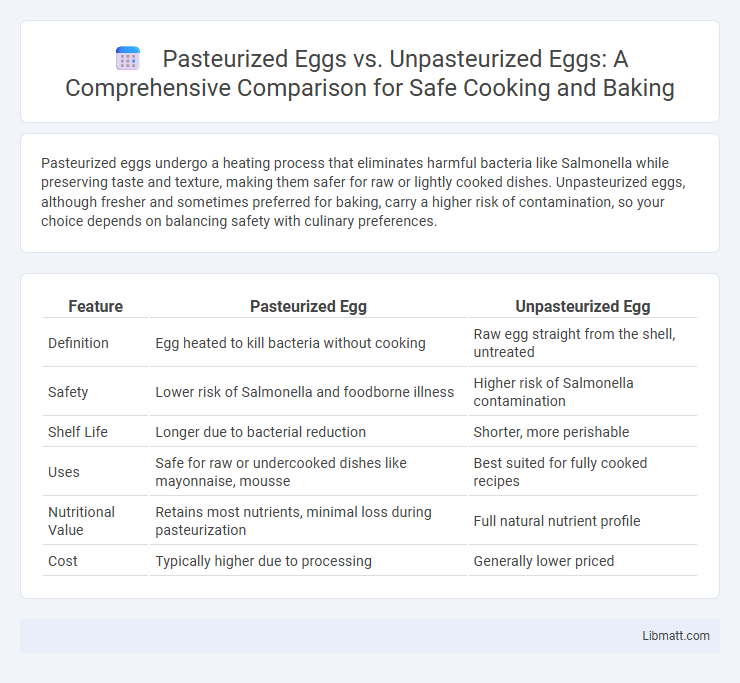Pasteurized eggs undergo a heating process that eliminates harmful bacteria like Salmonella while preserving taste and texture, making them safer for raw or lightly cooked dishes. Unpasteurized eggs, although fresher and sometimes preferred for baking, carry a higher risk of contamination, so your choice depends on balancing safety with culinary preferences.
Table of Comparison
| Feature | Pasteurized Egg | Unpasteurized Egg |
|---|---|---|
| Definition | Egg heated to kill bacteria without cooking | Raw egg straight from the shell, untreated |
| Safety | Lower risk of Salmonella and foodborne illness | Higher risk of Salmonella contamination |
| Shelf Life | Longer due to bacterial reduction | Shorter, more perishable |
| Uses | Safe for raw or undercooked dishes like mayonnaise, mousse | Best suited for fully cooked recipes |
| Nutritional Value | Retains most nutrients, minimal loss during pasteurization | Full natural nutrient profile |
| Cost | Typically higher due to processing | Generally lower priced |
Introduction to Pasteurized vs Unpasteurized Eggs
Pasteurized eggs undergo a controlled heating process to eliminate harmful bacteria such as Salmonella, making them safer for raw or lightly cooked dishes. Unpasteurized eggs retain their natural state without heat treatment, offering a fresher taste but posing a higher risk of bacterial contamination. Consumers choose pasteurized eggs particularly for recipes like mayonnaise or hollandaise sauce, where eggs remain uncooked.
What Are Pasteurized Eggs?
Pasteurized eggs are eggs that have been heated to a specific temperature to kill harmful bacteria like Salmonella without cooking the egg itself, ensuring safety for raw or lightly cooked dishes. This process maintains the egg's texture and flavor, making them ideal for recipes such as homemade mayonnaise, hollandaise sauce, or Caesar dressing. Choosing pasteurized eggs reduces the risk of foodborne illness, giving you peace of mind when consuming foods that traditionally require raw eggs.
What Are Unpasteurized Eggs?
Unpasteurized eggs are raw eggs that have not undergone the heat treatment process used to eliminate harmful bacteria such as Salmonella. These eggs retain their natural state, offering fresh flavor and texture but pose a higher risk of foodborne illness if consumed raw or undercooked. Commonly sourced from backyard chickens or certain farms, unpasteurized eggs require careful handling and thorough cooking to ensure safety.
Key Differences Between Pasteurized and Unpasteurized Eggs
Pasteurized eggs undergo a controlled heating process to eliminate harmful bacteria like Salmonella, ensuring higher food safety compared to unpasteurized eggs, which retain their natural bacteria levels. Pasteurization slightly alters the egg's protein structure, making pasteurized eggs ideal for recipes requiring raw or lightly cooked eggs such as sauces and dressings. Unpasteurized eggs offer a richer flavor and are preferred for traditional baking and cooking methods where the eggs are thoroughly cooked.
Safety and Health Risks
Pasteurized eggs undergo a mild heat treatment that eliminates harmful bacteria like Salmonella, significantly reducing your risk of foodborne illness compared to unpasteurized eggs. Unpasteurized eggs carry a higher chance of contamination, posing safety concerns especially for vulnerable groups such as pregnant women, young children, and the elderly. Choosing pasteurized eggs ensures safer consumption, particularly when using raw or lightly cooked eggs in recipes.
Nutritional Comparison
Pasteurized eggs retain most of the nutritional value found in unpasteurized eggs, including high-quality protein, essential amino acids, vitamins A, D, B12, and minerals like selenium and iron. The pasteurization process slightly reduces heat-sensitive nutrients but does not significantly impact the overall nutrient profile or bioavailability. You can safely choose pasteurized eggs for raw or undercooked recipes without compromising essential nutrients critical for a balanced diet.
Taste and Texture Differences
Pasteurized eggs have a slightly firmer texture and a milder flavor compared to unpasteurized eggs, which tend to be creamier and richer due to their raw state. The heat treatment in pasteurization can cause subtle changes in protein structure, resulting in less vibrant yolks and whites. Culinary applications requiring raw or lightly cooked eggs often prefer unpasteurized eggs for their superior taste and smooth texture.
Culinary Uses and Applications
Pasteurized eggs are ideal for recipes requiring raw or lightly cooked eggs, such as Caesar salad dressing, mayonnaise, and hollandaise sauce, because they reduce the risk of Salmonella contamination without compromising texture or flavor. Unpasteurized eggs are preferred in baked goods and dishes where higher heat is applied, like cakes, custards, and meringues, as they offer a more natural egg taste and better foaming properties. Chefs often select pasteurized eggs for cold preparations and unpasteurized eggs for traditional cooking methods to balance safety and culinary quality.
Cost and Availability
Pasteurized eggs typically cost 20-30% more than unpasteurized eggs due to the additional heat treatment process ensuring safety from Salmonella. These eggs are widely available in supermarkets, especially in urban areas with higher demand for food safety, while unpasteurized eggs remain more common in farmers' markets and local stores. Pasteurized eggs may have limited availability in rural regions, often requiring purchase from specialty stores or online retailers.
Which Egg Should You Choose?
Choosing between pasteurized and unpasteurized eggs depends on your health priorities and recipe requirements. Pasteurized eggs undergo a heat treatment that kills harmful bacteria like Salmonella, making them safer for raw or lightly cooked dishes such as Caesar dressing or homemade mayonnaise. If you prioritize food safety and plan to consume eggs in uncooked or partially cooked forms, your best choice is pasteurized eggs.
Pasteurized Egg vs Unpasteurized Egg Infographic

 libmatt.com
libmatt.com